A Man and His Dragons in Southern Thailand
Story and photos by Tim Leffel
On a Thailand tour that's supposed to highlight pristine, unpopulated islands, the highlight turns out to be a man-made attraction created by a driven artist who turns roots into mythical creatures.

There was little fanfare when we parked in front of Wang Thep Taro and the advance info on our itinerary billed it as a non-eventful stop. This was supposed to be "an ordinary house of a local villager where he runs his home business based on self-sufficiency economy with the local wisdoms by using Theptaro wood as the main material." It was clear from first glance though that whoever created this place was no ordinary wood carver.
Flowing off in both directions from the front gate were intricately built dragons fashioned from curving tree roots. They snaked around the grounds and wove into one another like a school of frolicking sea creatures swimming together and striking fear in the heart of sailors. I got out of the van, stood a few seconds gaping with my mouth open, then worked on maxing out my camera's memory card.
The big draw of this tour was supposed to be island-hopping in the Trang and Satun regions of Thailand. We would be landing on beautiful secluded beaches and seeing the kind of turquoise waters that grace magazine covers and make people drool. We would lounge on hammocks drinking from a coconut and take photos that didn't require any filters to look perfect. A few hours south of Krabi and Phi Phi but with far fewer tourists, this was going to be dreamy. Our woodcarver stop was just something to fill up some time after breakfast near the Trang capital city.
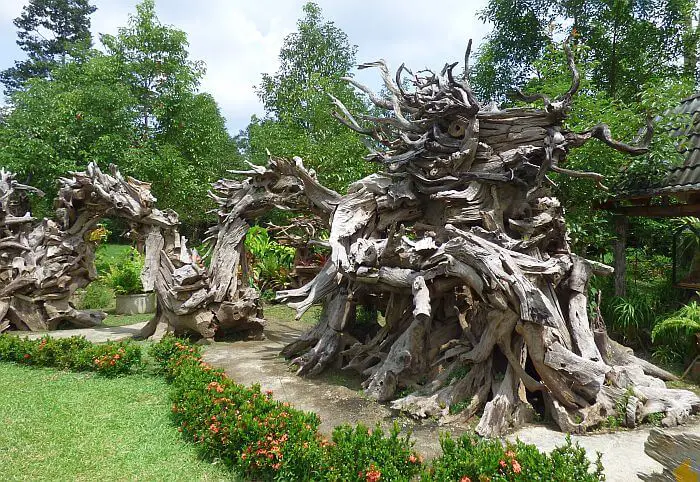
Smog in Paradise
When we arrived, however, it became a dream without much clarity. Further south in Borneo and Sumatra of Indonesia, farmers had been burning their fields for weeks after harvest time. In northern Thailand and Burma they were doing the same. Every year there's a respiratory emergency in a huge section of the globe. This year the haze was big enough to obscure satellite photos of the land and the carbon output was estimated to be greater than the entire output of the United States. As usual, everyone complained, but the various govenments were unable to do much more than send some firefighters to keep things from getting worse when the fires spread into forests.
The winds were blowing north that week, so smoke rolled across Singapore, Malaysia, and all the way up to Ko Chang in Thailand, making our trips between islands like boat rides in a permanent fog. We were just two kilometers away from the island of Ko Muk before we could even see it. The boat anchored and we swam into a dark cave, coming out on the other end into an area that made us forget all about the air outside. After following a guide with a headlamp, we emerged onto a beach surrounded on all other sides by sheer limestone walls. This natural hideout is protected Morakot Park, also known as the Emerald Cave. In this little enclosed space with its green water and dramatic entrance, we could forget for a while about the soupy air outside.
Over the next couple days we zipped from one island to another, but the view above the water was seldom the kind that inspired anyone to reach for their camera. Instead we chatted and daydreamed, looking forward to landings where we would go snorkeling among the colorful coral underwater, where the haze above didn't matter.
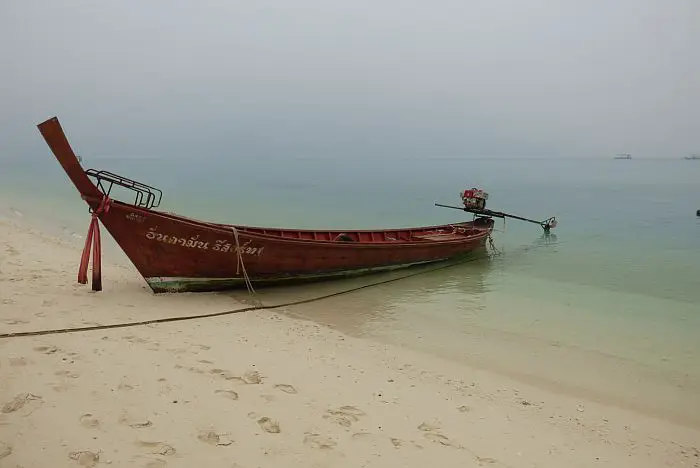
The Old Man and the Dragons
The sign in the center of the sculpture park reads "Pay respect to the Earth" in Thai. Others scattered along walking paths offer words of wisdom in two languages, including "Be powerful like a dragon." I'm didn't feel so powerful in this tropical heat, just five minutes in the sun turning my shirt into a sweaty mess.
Holding court in a shaded pavilion was the man behind all this, Mr. Jaroon Keawla-eiad. ("That's probably not a perfect spelling," my guide explained. "Some Thai words don't translate very well into English letters.") He is a retired local school teacher that took over this land of theptaro trees many decades ago and made a dragon from the curvy tree's roots. Then he made another, and one after that, then kept going. There are now 88 of them on the property.
He keeps the sad original dragon he created first on display, very close to his most recent incredible creation. The original is like a child's drawing compared to an adult masterpiece, or in monster terms, like the original 1954 black and white Godzilla creature compared to fierce Smaug in The Hobbit. The progression of his skill is amazing, with the dragons evolving over time into fluid designs that almost look like they're moving. They look vividly different from alternate angles and seem to change shape as the arc of the sun moves the shadows.
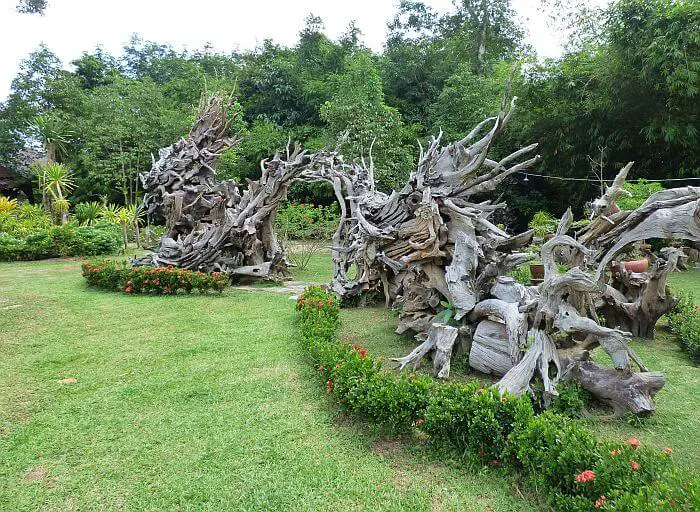
"I had all these roots on the land from taro trees that had been cut down," he tells us through a translator, and I thought one of them looked like the head of a dragon, so I made the first one from just a few pieces." The next one was a bit bigger and better and as his skill grew they got more ambitious. He points to one near us in the pavilion and says it was carved from an especially large root that was at least 300 years old.
Now the area is a tourist attraction and a carving school teaches locals a useful trade. Admission is free for visitors, so the business earns money mostly through selling oil and carvings. Several wealthy visitors have offered the owner big bucks for some of his dragons, but he doesn't want to part with any of them.
Walking around and seeing how much work went into all this just for the sake of art, I was reminded of visiting the home and studio of folk artist Howard Finster in rural Georgia in my younger days in the USA. He was clearly driven by a calling from God. Former British high society member Edward James was driven by a desire to create a surrealist paradise like no other in the jungle when creating his bizarre concrete sculptures near Xilitla, Mexico.
Mr. Jaroon says his drive comes from a burning desire to showcase a native Thai tree that has a multitude of uses.
The Tree That Keeps on Giving
The local theptaro tree has been neglected over time in southern Thailand, thought of as just another wood source for building materials. Farmers often cleared the trees by the dozens to make room for more profitable rubber trees. It's an extremely versatile plant, however. Cooks and herbal medicine doctors both use its fragrant leaves and flowers. The wood is not only a good carving material for Buddha statues and animal sculptures, but the extracted oil is used as an antiseptic and to treat conditions like acne and athlete's foot. The oil also makes its way into some spa treatments. Impervious to insects and resistant to the elements, the wood can sit exposed for decades without deteriorating.
The roots were usually cast aside, however, which is how so many dragons came to grace this land. The 88 of them are now scattered around the grounds and under pavilions on two sides of a rural road that doesn't get much traffic. Apparently four years ago there were 84 dragons—each year Mr. Jaroon creates a new one.
Here the story gets a little fuzzy though as the number is supposed to correspond to his age. Even discounting the dyed hair and healthy Thai diet, however, it's hard to believe this spry man who led us around his grounds is anywhere close to that age. After bouncing around from spot to spot, showing us different pieces and explaining the health properties of his trees, we felt tapped out but he didn't.
He then led us to another section of the property where he has rubber trees planted and I followed him as he started down a path that circled the whole plantation section. The main purpose for him seemed to be to get a little more exercise. With the thermometer hovering around 95F/35C though, for me it meant another liter of sweat pouring out of my body. Maybe if he does this a few times a day and keeps busy, he could just be the world's healthiest 88-year-old. Only his family knows for sure.
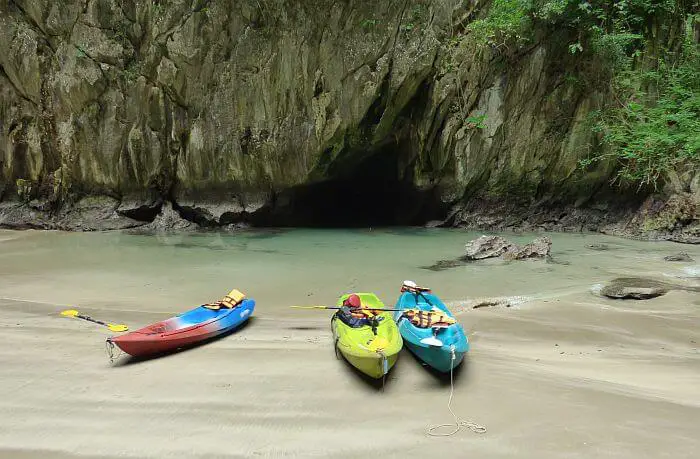
Dragons in the Water
We spent the rest of our time in Trang and Satun sticking to the itinerary, visiting our islands and attractions despite the haze unleashed upon us from a million burning acres to the south. The best turned out to be in another spot where the air quality made no difference: a canoe trip through a four-kilometer cave system where the only illumination was our flashlights.
The last day of our tour, between islands Koh Hin Ngam and Koh Lipe in Satun, I could make out three humps in the distance, plus a small protrusion in front of them all. On a day with normal visibility they would be rocky tropical inlets covered by bright green vegetation. In the soupy air I could easily imagine how legends are formed. It didn't take much imagination to turn this into a giant sea creature who get frozen in place by some spell or will of an angry god.
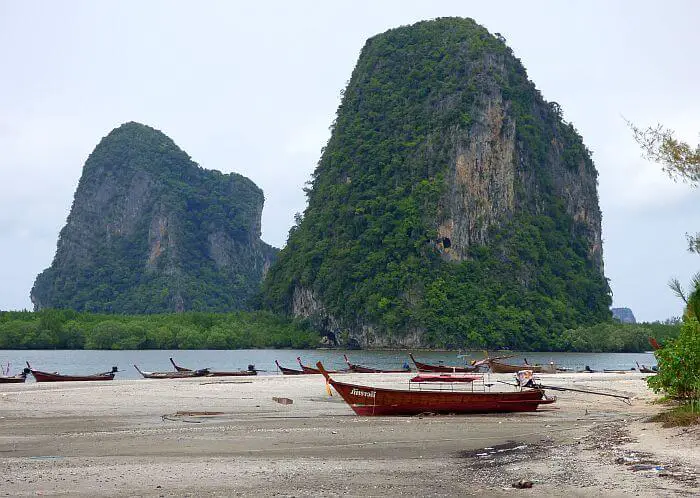
Dragons come alive easily in our imagination. Mr. Jaroon went one step further and brought them to life through discarded tree roots.
If You Go:
Wang Theptaro (also known as Wang Etptaor) is tough to get to by public transportation, so get directions from the tourism office in Trang's capital city or get their help arranging a taxi or tour. Few western travelers make it to this part of Thailand a few hours south of Krabi, so bring a good phrase book or app. To go island-hopping, just head to a port and find a tour company. Most lead scheduled group excursions or you can hire a private boat. See the Trang section of the Tourism Thailand website for information in English. Search flights to Thailand here and see this article for the many domestic airlines in Thailand to choose from.
Editor Tim Leffel is an award-winning travel writer and blogger who is based in Mexico when not moving around as a nomad. He is author of several books, including The World's Cheapest Destinations, Travel Writing 2.0, and A Better Life for Half the Price on living abroad. See his long-running Cheapest Destinations blog at that link.
Related features:
Pierced Cheeks and Pain in Trang, Thailand by Tony Robinson-Smith
Thailand on Three Wheels—With and Without an Engine by Bruce Northam
Learning to Walk Fully in Thailand by Luke Maguire Armstrong
Vientiane Buddha Park: the Legacy of Bunleua Sulilat by James Michael Dorsey
See other Asia travel stories in the archives.
Copyright © Perceptive Travel 2023. All rights reserved.
- Bridging the Gaps in Calcutta by Jim Johnston
- Sharing the Republic of Georgia With the Street Dogs by K. Krombie
- Trying to Feel at Home in a Grand Castle in Ireland by Gillian Kendall
- Travel Book Reviews by Susan Griffith
Books from the Author:

Buy A Better Life for Half the Price at your local bookstore, or get it online here:
Amazon US
Amazon Canada
Amazon UK
E-reader versions

Buy The World's Cheapest Destinations: 26 Countries Where Your Travel Money is Worth a Fortune at your local bookstore, or get it online here:
Amazon
Amazon Canada
Amazon UK
Kobo

Buy Make Your Travel Dollars Worth a Fortune: The Contrarian Traveler's Guide to Getting More for Less at your local bookstore, or get it online here:
Amazon
Kobo

